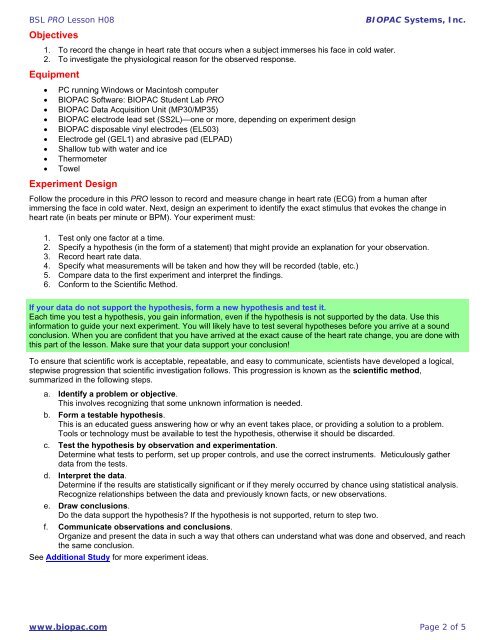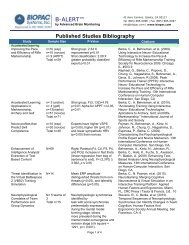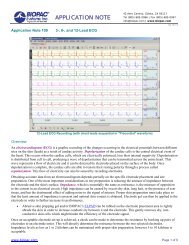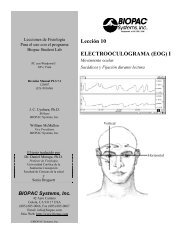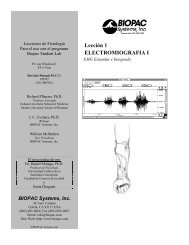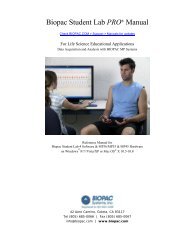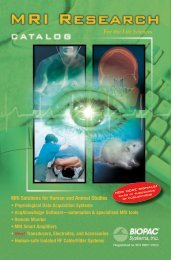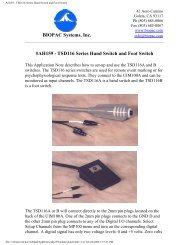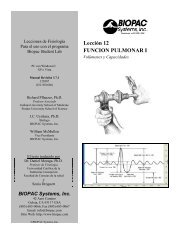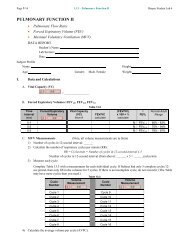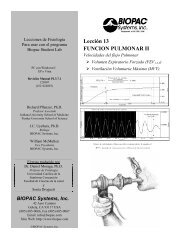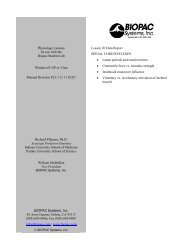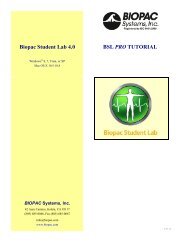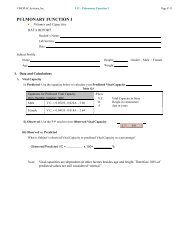BSL PRO Lesson H11 - Biopac
BSL PRO Lesson H11 - Biopac
BSL PRO Lesson H11 - Biopac
- No tags were found...
You also want an ePaper? Increase the reach of your titles
YUMPU automatically turns print PDFs into web optimized ePapers that Google loves.
<strong>BSL</strong> <strong>PRO</strong> <strong>Lesson</strong> H08Objectives1. To record the change in heart rate that occurs when a subject immerses his face in cold water.2. To investigate the physiological reason for the observed response.Equipment• PC running Windows or Macintosh computer• BIOPAC Software: BIOPAC Student Lab <strong>PRO</strong>• BIOPAC Data Acquisition Unit (MP30/MP35)• BIOPAC electrode lead set (SS2L)—one or more, depending on experiment design• BIOPAC disposable vinyl electrodes (EL503)• Electrode gel (GEL1) and abrasive pad (ELPAD)• Shallow tub with water and ice• Thermometer• TowelExperimentDesignBIOPAC Systems, Inc.Follow the procedure in this <strong>PRO</strong> lesson to record and measure change in heart rate (ECG) from a human afterimmersing the face in cold water. Next, design an experiment to identify the exact stimulus that evokes the change inheart rate (in beats per minute or BPM). Your experiment must:1. Test only one factor at a time.2. Specify a hypothesis (in the form of a statement) that might provide an explanation for your observation.3. Record heart rate data.4. Specify what measurements will be taken and how they will be recorded (table, etc.)5. Compare data to the first experiment and interpret the findings.6. Conform to the Scientific Method.If your data do not support the hypothesis, form a new hypothesis and test it.Each time you test a hypothesis, you gain information, even if the hypothesis is not supported by the data. Use thisinformation to guide your next experiment. You will likely have to test several hypotheses before you arrive at a soundconclusion. When you are confident that you have arrived at the exact cause of the heart rate change, you are done withthis part of the lesson. Make sure that your data support your conclusion!To ensure that scientific work is acceptable, repeatable, and easy to communicate, scientists have developed a logical,stepwise progression that scientific investigation follows. This progression is known as the scientific method,summarized in the following steps.a. Identify a problem or objective.This involves recognizing that some unknown information is needed.b. Form a testable hypothesis.This is an educated guess answering how or why an event takes place, or providing a solution to a problem.Tools or technology must be available to test the hypothesis, otherwise it should be discarded.c. Test the hypothesis by observation and experimentation.Determine what tests to perform, set up proper controls, and use the correct instruments. Meticulously gatherdata from the tests.d. Interpret the data.Determine if the results are statistically significant or if they merely occurred by chance using statistical analysis.Recognize relationships between the data and previously known facts, or new observations.e. Draw conclusions.Do the data support the hypothesis? If the hypothesis is not supported, return to step two.f. Communicate observations and conclusions.Organize and present the data in such a way that others can understand what was done and observed, and reachthe same conclusion.See Additional Study for more experiment ideas.www.biopac.com Page 2 of 5


